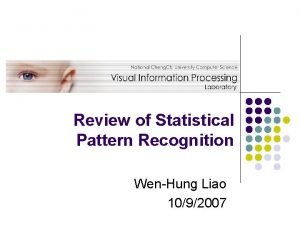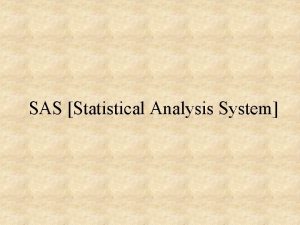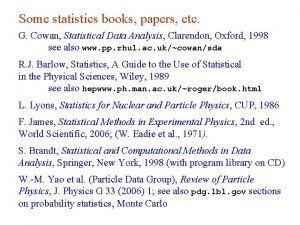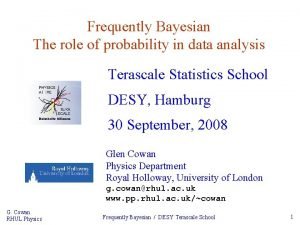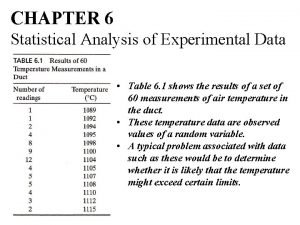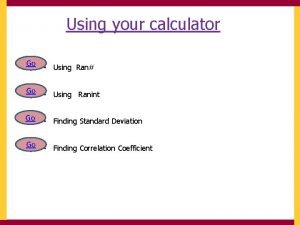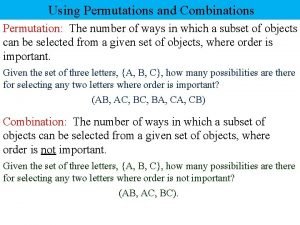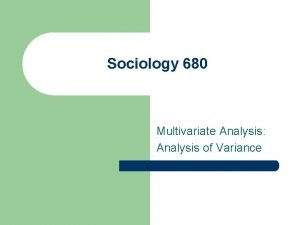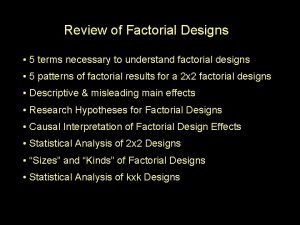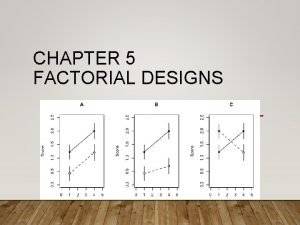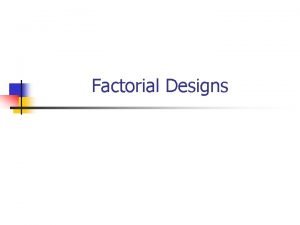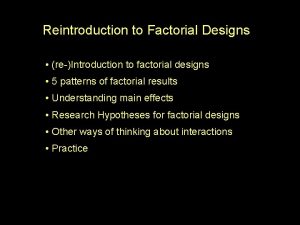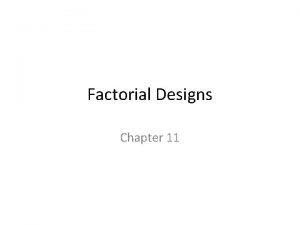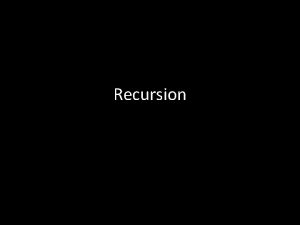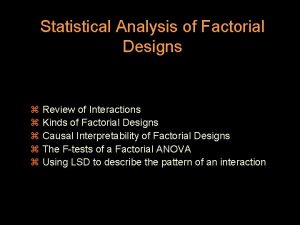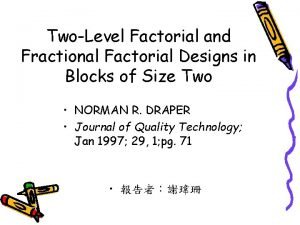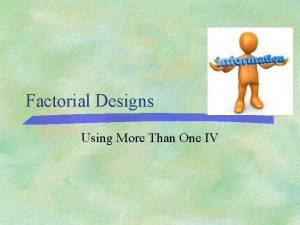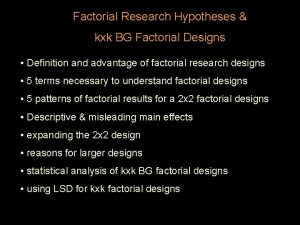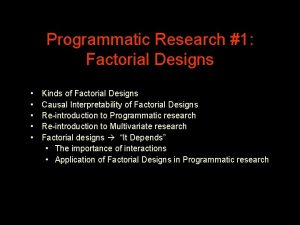Statistical Analysis of Factorial Designs z Review of
























- Slides: 24

Statistical Analysis of Factorial Designs z Review of Interactions z Interactions in Tables and Line Graphs z The F-tests of a Factorial ANOVA z Using LSD to describe the pattern of an interaction

Interpreting Factorial Results based on “Inspection” Now that we have the basic language we will practice examining and describing main effects and interactions based on tables, line graphs and bar graphs portraying factorial results. Once you know how to describe the results based on “inspection” it will be a very simple task to learn how to apply NHST to the process. As in other designs we have looked at “an effect” as a numerical difference between two “things”, in factorial analyses… Main effects involve differences between marginal means. Simple effects involve differences between cell means. Interactions involve the differences between simple effects.

Inspecting a Table to determine simple effects & interaction… Task Presentation Paper Computer Task Difficulty Easy 90 Hard 50 90 70 We’ll look at describing the interaction using each set of simple effects in turn. Then we’ll look at describing each main effect (and checking if each is descriptive or misleading)

Inspecting a Table to determine simple effects & interaction… Simple Effects of Task Presentation Task Difficulty Task Presentation Paper Computer Easy 90 90 Hard 50 70 SE of Task Pres for Easy. Tasks 90 vs. 90 SE = 0 SE of Task Pres for Hard. Tasks 50 vs. 70 SE = 20 There is an interaction of Task Difficulty and Task Presentation as they relate to performance. There is no effect of presentation for easy tasks, however for hard tasks computer presentations led to higher scores than did paper presentations.

Inspecting a Table to determine simple effects & interaction… Simple Effects of Task Difficulty SE of Task Diff for Paper Pres. Task Presentation Paper Computer 90 vs. 50 SE = 40 Easy 90 90 Hard 50 70 SE of Task Diff for Computer Pres. 90 vs. 70 SE = 20 There is an interaction of Task Difficulty and Task Presentation as they relate to performance. Easy tasks are consistently performed better than hard tasks, however this effect is larger for paper presentations than for computer presentations.

Inspecting a Table to determine main effects … Task Difficulty Easy marginal means for Task Difficulty 90 vs. 60 Easy > Hard Task Presentation Paper Computer 90 90 90 This main effect is descriptive. . Easy > Hard for BOTH Hard 50 70 60 Paper & Computer tasks Overall, easy tasks were performed better than hard tasks.

Inspecting a Table to determine main effects … marginal means for Task Presentation 70 vs. 80 Paper < Computer Task Difficulty Easy Hard Paper 90 50 Computer 90 70 This main effect is potentially misleading. . . Paper < Computer only for hard tasks Paper = Computer for easy tasks 70 80 Overall, there was better performance on computer than paper tasks. However, this was not descriptive for easy tasks.

Inspecting a line graph … “Different differences” and “Differential Simple Effects” both translate into NONPARALLEL LINES in a figure. Performance 90 Key for Task Difficulty O = Easy X = Hard O 70 50 O X X 30 Paper Computer Task Presentation P C Easy 90 90 Hard 50 70

Inspecting a line graph to determine simple effects & interaction… Performance 90 O O 70 X 50 90 vs. 90 X Computer Task Presentation Key for Task Difficulty O = Easy X = Hard SE = 0 SE of Task Pres for Hard. Tasks 30 Paper Simple Effects of Task Presentation SE of Task Pres for Easy. Tasks 50 vs. 70 SE = 20 There is an interaction of Task Difficulty and Task Presentation as they relate to performance. There is no effect of presentation for easy tasks, however for hard tasks computer presentations led to higher scores than did paper presentations.

Inspecting a line graph to determine simple effects & interaction… Performance 90 Simple Effects of Task Difficulty O 70 50 O SE Task Diff for Paper Pres. X 90 vs. 50 SE = 40 SE Task Diff for Computer Pres. X 90 vs. 70 30 Paper Computer Task Presentation Key for Task Difficulty O = Easy X = Hard SE = 20 There is an interaction of Task Difficulty and Task Presentation as they relate to performance. Easy tasks are consistently performed better than hard tasks, however this effect is larger for paper presentations than for computer presentations.

How not to Inspect a line drawing to determine if there is an interaction… This is a “cross-over” interaction -- it certainly IS an interaction Performance but it IS NOT the only kind !! 90 70 50 30 Paper Computer Task Presentation Key for Task Difficulty Easy Hard

Inspecting a line graph to determine if there are main effects… marginal means for Task Difficulty Performance 90 90 vs. 60 O O 70 50 X Easy > Hard This main effect is descriptive. . Easy > Hard for BOTH Paper & Computer tasks X 30 Paper Computer Task Presentation Key for Task Difficulty O = Easy X = Hard Overall, easy tasks were performed better than hard tasks.

Inspecting a line graph to determine if there are main effects… Performance 90 marginal means for Task Pres 70 vs. 80 Paper < Computer O O 70 50 X This main effect is potentially misleading. . . Paper < Computer for hard tasks X but. . . 30 Paper Computer Paper = Computer for easy tasks Task Presentation Key for Task Difficulty O = Easy X = Hard Overall, there was better performance on computer than paper tasks. However, this was not descriptive for easy tasks.

Statistical Analysis of 2 x 2 Factorial Designs Like a description of the results based upon inspection of the means, formal statistical analyses of factorial designs has five basic steps: 1. Tell IVs and DV 2. Present data in table or figure 3. Determine if the interaction is significant • if it is, describe it in terms of one of the sets of simple effects. 4. Determine whether or not the first main effect is significant • if it is, describe it • determine if that main effect is descriptive or misleading 5. Determine whether or not the second main effect is significant • if it is, describe it • determine if that main effect is descriptive or misleading

Interpreting Factorial Effects Important things to remember: • main effects and the interaction are 3 separate effects each must be separately interpreted -- three parts to the “story” • most common error -- “interaction is different main effects” • best thing -- be sure to carefully separate three parts of the story and tell each completely • Be careful of “causal words” when interpreting main effects and interactions (only use when really appropriate). • caused, effected influenced, produced, changed …. • Consider more than the “significance” • consider effect sizes, confidence intervals, etc. when describing the results

Statistical Analysis of a 2 x 2 Design Task Presentation (a) Paper Computer SE of Presentation for Easy Tasks Task Difficulty (b) Easy 90 70 80 Hard 40 60 50 65 65 Presentation Main Effect Difficulty Main Effect FPresentation FDificulty 65 vs. 65 80 vs. 50 SE for Presentation for Hard Tasks Interaction Effect FInteraction SEEasy vs. SEHard

Statistical Analyses Necessary to Describe Main Effects of a 2 x 2 Design In a 2 x 2 Design, the Main effects F-tests are sufficient to tell us about the relationship of each IV to the DV… • since each main effect involves the comparison of two marginal means -- the corresponding significance test tells us what we need to know … • whether or not those two marginal means are “significantly different” • Don’t forget to examine the means to see if a significant difference is in the hypothesized direction !!!

Statistical Analyses Necessary to Describe the Interaction of a 2 x 2 Design However, the F-test of the interaction only tells us whether or not there is a “statistically significant” interaction… • it does not tell use the pattern of that interaction • to determine the pattern of the interaction we have to compare the simple effects • to describe each simple effect, we must be able to compare the cell means we need to know how much of a cell mean difference is “statistically significant”

Using LSD to Compare cell means to describe the simple effects of a 2 x 2 Factorial design • LSD can be used to determine how large of a cell mean difference is required to treat it as a “statistically significant mean difference” • Will need to know three values to use the computator • dferror -- look on the printout or use N – 4 • MSerror – look on the printout • n =N/4 -- use the decimal value – do not round to the nearest whole number! Remember – only use the lsdmmd to compare cell means. Marginal means are compared using the man effect F-tests.

Applying lsdmmd to 2 x 2 BG ANOVA Task Presentation Paper Computer Task Difficulty Easy Hard 60 90 60 70 Is there an Interaction? Based on what? for the interaction F(1, 56) = 6. 5, Mse= 300, p =. 023 Yes! F-test of Int What info do we need to compute the LSDmmd? k = 4 groups n = (df + k) / k = (56 + 4) / 4 = 15 MSe = 6. 5 df error = 56 (round down to 50)

Remember to set the dferror using the drop-down menu! With an LSDmmd = 12. 7 Simple effect of Task Presentation SE of Task Presentation for Easy Tasks SE of Task Presentation for Hard Tasks > = 0 = 20 > Simple effects of Task Difficulty SE of Task Difficulty for Paper Pres. SE of Task Difficulty for Comp. Pres. 30 10

Applying lsdmmd to 2 x 2 BG ANOVA Task Difficulty Easy Hard Task Presentation Paper Computer 60 90 75 60 70 65 for Difficulty ME F(1, 56) = 4. 5, p =. 041 lsdmmd = 12. 7 Is there a Task Difficulty main effect? Based on what? Yes! F-test of ME Is main effect descriptive (unconditional) or potentially misleading (conditional)? Simple effects of Task Difficulty 0 = 20 > SE of Task Difficulty for Paper Pres. SE of Task Difficulty for Comp. Pres. Descriptive only for Computer presentation; misleading for Paper presentations.

Applying lsdmmd to 2 x 2 BG ANOVA Task Difficulty Easy Hard Task Presentation Paper Computer 60 90 60 70 60 80 for Presentation ME F(1, 56) = 7. 2, p =. 011 lsdmmd = 12. 7 Is there a Task Difficulty main effect? Based on what? Yes! F-test of ME Is main effect descriptive (unconditional) or potentially misleading (conditional)? Simple effects of Task Difficulty 30 < SE of Task Presentation for Easy Tasks SE of Task Presentation for Hard Tasks 10 Descriptive only for Easy tasks; misleading for Difficult tasks. =

Effect Sizes for 2 x 2 BG Factorial designs For Main Effects & Interaction (each w/ df=1) r = [ F / (F + dferror)] For Main Effects & Simple Effects d = (M 1 - M 2 ) / Mserror r = d² -----d² + 4 (This is an “approximation formula”)
 Factorial design
Factorial design Bp statistical review of world energy 2009
Bp statistical review of world energy 2009 Bp statistical review
Bp statistical review Statistical pattern recognition a review
Statistical pattern recognition a review Bp statistical review of world energy 2014
Bp statistical review of world energy 2014 Statistical analysis system
Statistical analysis system Ascenex
Ascenex Preserving statistical validity in adaptive data analysis
Preserving statistical validity in adaptive data analysis Multivariate statistical analysis
Multivariate statistical analysis Cowan statistical data analysis
Cowan statistical data analysis Statistical business analysis
Statistical business analysis Marketing analytics software r
Marketing analytics software r State bayes theorem
State bayes theorem Statistical analysis of experimental data
Statistical analysis of experimental data Standard deviation calculator
Standard deviation calculator How to calculate the number of permutations
How to calculate the number of permutations Between subjects factorial design
Between subjects factorial design Factorial anova
Factorial anova Main effects statistics
Main effects statistics Between or within subjects
Between or within subjects Descomposición factorial
Descomposición factorial What is 5 factorial
What is 5 factorial 1000 factorial
1000 factorial Haskell factorial
Haskell factorial 8 factorial
8 factorial



